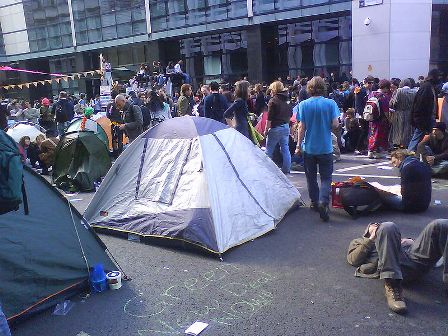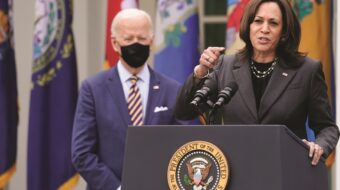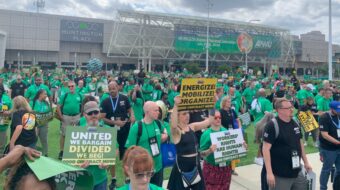
For the last three months this newspaper has covered jobs conferences, jobs seminars and job creation think tank gatherings too numerous to count.
With the latest unemployment figures surging above 10 percent and almost 16 million officially on the jobless rolls the time for talk is over.
While the times certainly called for the convening of the White House jobs conference last week even there too much of the discussion focused on long-term job creation in industries and occupations that don’t yet exist.
There are many millions of skilled and willing jobless ready to go to work today. The only missing element is someone to hire them. Private industry has made it clear that it has no intention of hiring them any time soon.
Some of the business people at the White House gathering said the reason your neighbor across the street or the guy who lives upstairs is out of work is because banks won’t lend the money to companies so they can create jobs.
Thea Lee, the AFL-CIO’s policy director, came a lot closer to putting her finger on the real problem, however. She argued that businesses really have no reason to hire right now, regardless of whether they can more easily pocket those bank loans.
What is really happening is that no one is running out to buy products. The unemployed don’t have the money and everyone else, watching the value of their homes evaporate, their savings dry up and fearing that they too will join the legions of jobless, is too scared to buy products.
We can agree, then, that private industry will not solve the economic crisis because it will not hire anybody.
“OK,” we’re tempted to say, “That leaves the government – it should do the hiring.”
State and local governments, perhaps? Sorry, putting people on payroll costs money. With the diminished tax revenues resulting from the Great Recession the money isn’t there, especially since state and local governments are required to balance their budgets. In fact, the only reason these state and local governments did not have to fire 300,000 workers in the last eight months is because they got money from the first stimulus program. Essentially, government on this level was able to save but not create some jobs.
So how about the federal government?
Overall, there is a hiring freeze going on there too.
And even when they do hire it is with a process from hell. Anyone who has ever applied for a federal government job will tell you that when you do manage to get your hands on or your computer to download a federal job application it will be a minimum of a year before anyone even looks at it and perhaps another year or more to get a decision on whether you are accepted and perhaps still another year after that before you are hired. Not too helpful for the millions out of work now.
In any case, the federal government cannot employ the almost 16 million who are jobless. It only has a little more than 2 million people on its payroll right now.
All of this leaves us with only one real way to put millions of unemployed back to work right now. It’s an idea being pushed by a number of people, although too few in government. The exception in Congress is Rep. Phil Hare, D-Ill., who says FDR’s New Deal must be re-created and that it must be done immediately. It worked before and it can work again.
In the 1930’s construction workers were unemployed. They were put to work building roads and bridges we have used ever since. Much of that network is at the end of its life. (This includes the city streets that millions negotiate every day.)
In the 1930’s artists were unemployed. The New Deal hired them and they gave us fantastic murals, mosaics and monuments in our public places. Who would argue that every one of us wouldn’t be better off with some more of these masterpieces in our towns and cities.
How often do we think about who it was that planted all those trees in our national forests and parks, and built all those lodges, cabins and trail shelters in Yosemite, Yellowstone and elsewhere. It was unemployed people hired by the Civilian Conservation Corp. in the 1930’s. Why not do this again and in more places?
In the 1930’s writers and skilled advertising people were out of work. The Federal Writers Project subsidized play and book writing and all kinds of other literary pursuits. The out-of-work advertising people were hired to do public service campaigns. Some of the best in our history came out of these projects including the iconic “Smokey the Bear” and “Only You Can prevent Forest Fires.”
In the 1930’s factory workers were out of work. Many got New Deal jobs building the ships and the airplanes that were used to win the war against fascism. Detroit car factories ended up building tanks. Why not hire people to begin re-tooling them to build light rail mass transit today?
In the 1930’s white collar workers with college degrees were unemployed. The New Deal hired many of them into the regulatory bodies it set up to control the worst excesses of capitalism and to regulate private industry until it became part of a new, fairer and growing economy. Hiring some of our college graduates to do this again, today, seems like a worthwhile idea. It certainly beats sending them to Wall Street where they work on devising methods that ruin both the economy and eventually, their own livelihoods.
To top it all off, the private sector doesn’t really have to be left out. The government can help make it worth while to hire with tax credits and salary subsidies for hiring, training, or retaining workers. There can be tax penalties and withholding of government contracts from companies that don’t get with the program.
When you piece it all together there is a solution. A new New Deal is the way to get the unemployed back to work right now.
Photo: http://www.flickr.com/photos/suchandrika/ / CC BY 2.0












Comments